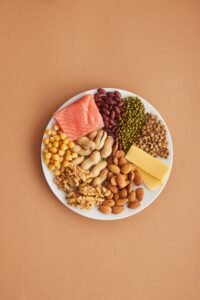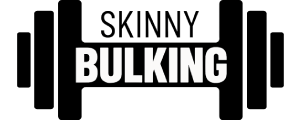For skinny guys, gaining muscle mass can be a challenging and frustrating experience. No matter how much they eat or exercise, it seems like they just can’t put on any muscle. However, with the right approach, gaining muscle mass can be achievable even for the skinniest of guys. In this blog post, we will explore two science-backed ways for skinny guys to bulk up and gain muscle mass quickly. We will dive deep into the science behind muscle growth and give you practical tips on how to implement these strategies in your workout routine. Whether you’re a beginner or have been lifting weights for years, these tips will help you achieve your muscle-building goals and get the physique you’ve always wanted. So, let’s get started on bulking up!
1. The challenges of gaining muscle mass for skinny guys

Image: pexels
For skinny guys, gaining muscle mass can be a challenging process. Unlike some people who seem to build muscle easily, skinny guys often find it difficult to gain any significant amount of muscle mass, even with intense workouts and a high-protein diet. This is because skinny guys tend to have a faster metabolism, which can make it harder for them to gain weight and build muscle. Additionally, they may have a smaller frame, which means they have less muscle mass to begin with.
Another challenge that skinny guys face is that they may be more prone to injury if they try to lift too heavy too quickly. Without proper form and technique, it’s easy to strain or injure muscles, which can set back progress and cause further frustration.
Despite these challenges, it’s important for skinny guys to know that gaining muscle mass is possible with the right approach. By understanding their body type, setting realistic goals, and following science-backed strategies, skinny guys can bulk up and achieve their desired physique.
2. The importance of proper nutrition
When it comes to gaining muscle mass, proper nutrition is crucial. No matter how hard you train, if you don’t fuel your body with the right nutrients, you won’t see the results you desire.
The first step is to make sure you’re consuming enough calories. You need to be in a calorie surplus in order to build muscle. This means consuming more calories than your body burns in a day. To find out how many calories you need, calculate your basal metabolic rate (BMR) using an online calculator and add on an additional 500-1000 calories per day.
Next, you need to make sure you’re consuming enough protein. Protein is essential for muscle growth and repair. Aim for at least 1 gram of protein per pound of body weight. Good sources of protein include lean meats, fish, eggs, dairy, and plant-based options such as beans and tofu.
In addition to protein, your diet should also include plenty of complex carbohydrates such as whole grains, fruits, and vegetables. These will provide your body with the energy it needs to fuel your workouts and help with muscle recovery.
Finally, don’t forget about healthy fats. These are important for hormone health and overall wellbeing. Good sources of healthy fats include nuts, seeds, avocado, and olive oil.
By following a well-rounded, balanced diet and making sure you’re in a calorie surplus with enough protein, carbs, and healthy fats, you’ll be on your way to gaining muscle mass fast.
3. How many calories should you be consuming?
When it comes to gaining muscle mass, calories are your friends. If you’re not consuming enough calories, your body won’t have the necessary fuel to build muscle. You’ll need to consume more calories than you burn on a daily basis to see any significant muscle growth.
But how many calories should you be consuming? It all depends on your body type, activity level, and goals. Generally speaking, a calorie surplus of 250-500 calories per day is a good starting point for lean muscle gain.
Keep in mind that not all calories are created equal. It’s important to focus on consuming nutrient-dense foods that will fuel your body and support muscle growth. Aim to eat plenty of protein, complex carbohydrates, and healthy fats.
Tracking your calorie intake can be helpful in making sure you’re consuming enough to support muscle growth. There are plenty of apps and websites available to help you track your daily calorie intake and macronutrient ratios.
Remember that patience is key when it comes to building muscle. It’s not going to happen overnight, but with consistent effort and a focus on proper nutrition, you’ll start to see results.
4. The role of protein in muscle growth

Image: pexels
Protein is a crucial component in the process of building muscle. It is a macronutrient that is essential for muscle growth and repair. When you exercise, especially when you lift weights, you create small tears in your muscle tissue. Protein helps to repair and rebuild this tissue, resulting in bigger and stronger muscles.
Studies have shown that eating a diet high in protein can help increase muscle mass and strength. The recommended daily intake of protein for muscle building is 1.6 grams per kilogram of body weight. This means that if you weigh 70 kilograms, you should be consuming around 112 grams of protein per day.
It’s also important to note that the timing of protein consumption is important. Consuming protein within 30 minutes after a workout can help maximize the muscle-building effects. This is because your muscles are more receptive to nutrients during this time, and consuming protein can help to kickstart the repair and growth process.
Sources of protein include lean meats such as chicken and turkey, fish, eggs, dairy products, and plant-based sources such as beans, lentils, and tofu. It’s important to choose high-quality sources of protein as they contain all the essential amino acids needed for muscle growth. Incorporating protein into your diet, especially after a workout, can help to maximize your muscle-building potential.
5. What are the best foods for gaining muscle mass?
When it comes to gaining muscle mass, nutrition plays a crucial role. Consuming the right foods in the right quantities can help you achieve your goals faster. Here are some of the best foods for gaining muscle mass:
1. Protein-rich foods: Protein is essential for muscle growth and repair. Foods such as chicken, turkey, fish, eggs, dairy products, and legumes are excellent sources of protein.
2. Carbohydrate-rich foods: Carbohydrates provide energy that fuels workouts and aids in muscle recovery. Opt for complex carbohydrates like whole grains, fruits, and vegetables.
3. Healthy fats: Healthy fats are essential for maintaining hormone levels and aiding in muscle growth. Include foods such as avocados, nuts, seeds, and olive oil in your diet.
4. Pre and post-workout meals: Eating a balanced meal before and after your workout can help fuel your muscles and aid in recovery. Opt for a combination of carbohydrates and protein.
Remember, it’s not just about what you eat but also how much you eat. To gain muscle mass, you need to consume more calories than you burn. So, make sure you are consuming a calorie surplus and aim to include these muscle-building foods in your diet.
6. Understanding the importance of strength training
When it comes to gaining muscle mass, strength training is one of the most important factors to consider. This is because strength training helps to stimulate muscle growth by breaking down muscle fibers and stimulating the body to rebuild them stronger and bigger than before.
In fact, research has shown that strength training can increase muscle mass by up to 10% in just a few weeks when combined with adequate nutrition and rest.
So, if you’re a skinny guy looking to bulk up fast, incorporating strength training into your workout routine is crucial. This can include exercises such as weight lifting, bodyweight exercises, resistance band training, and more.
It’s also important to focus on progressive overload, which means gradually increasing the weight or resistance used in your exercises over time. This helps to continually challenge your muscles and stimulate growth.
Remember, it’s important to consult with a qualified fitness professional before starting any new workout routine, especially if you’re a beginner. They can help you develop a safe and effective program that is tailored to your individual needs and goals.
7. What kind of exercises should you be doing?
When it comes to gaining muscle mass, the type of exercises you do matter just as much as the amount of weight you lift. Compound exercises that work multiple muscle groups at once should be prioritized over isolation exercises. This is because compound exercises stimulate the release of more testosterone and growth hormone, which are essential for muscle growth.
Exercises such as squats, deadlifts, bench press, pull-ups, and rows should be the foundation of your workout routine. These exercises not only target multiple muscle groups but also allow you to lift heavier weights which will lead to more muscle growth.
In addition to compound exercises, it’s important to incorporate progressive overload into your workouts. This means gradually increasing the weight you lift over time. This will force your muscles to adapt and grow in order to handle the increased workload.
However, it’s important to not neglect isolation exercises altogether. Isolation exercises can be used to target specific muscle groups that may not be targeted as effectively with compound exercises. Bicep curls, tricep extensions, and calf raises are examples of isolation exercises that can be added to your workout routine.
Remember, the key to gaining muscle mass is consistency and progressive overload. Stick to a consistent workout routine and gradually increase the weight you lift over time, and you’ll start to see results in no time.
8. How many sets and reps should you be performing?
When it comes to building muscle mass, the number of sets and reps you perform depends on your goals and fitness level. As a general rule, if you’re looking to build muscle mass quickly, you’ll want to aim for higher volume training, meaning more sets and reps.
Studies have shown that performing 3-6 sets of 6-12 reps per exercise can be effective for building muscle mass. This range of reps and sets is known as the hypertrophy range and has been shown to promote muscle growth and increase strength.
It’s also important to include a variety of exercises that target all major muscle groups, including the chest, back, legs, shoulders, and arms. Aim to perform compound exercises, such as squats, deadlifts, and bench presses, as well as isolation exercises, such as bicep curls and tricep extensions, to fully stimulate muscle growth.
Remember, it’s important to gradually increase the weight you’re lifting over time to continue to challenge your muscles and promote growth. However, it’s equally important to listen to your body and avoid overtraining, which can lead to injury and hinder progress.
9. The benefits of high-intensity interval training (HIIT)

Image: pexels
High-Intensity Interval Training (HIIT) is a form of exercise that has been gaining popularity in recent years due to its effectiveness in burning fat and building muscle mass. HIIT involves short bursts of intense exercise followed by periods of rest or low-intensity exercise.
One of the main benefits of HIIT is that it can be done in a shorter amount of time compared to traditional cardio exercises such as jogging or cycling. This makes it a great option for individuals who have busy schedules but still want to get a good workout in.
Moreover, HIIT can also help to increase your metabolism, which means that your body will continue to burn calories even after you have finished exercising. This is known as the afterburn effect, which can help to maximize fat loss and muscle gain.
In addition to its fat-burning benefits, HIIT has also been shown to increase muscle mass, particularly in the legs and core. This is due to the fact that HIIT involves explosive movements that engage multiple muscle groups at once, which can help to stimulate muscle growth.
Overall, incorporating HIIT into your workout routine can help you to achieve your fitness goals faster and more efficiently. However, it’s important to note that HIIT is a high-intensity exercise and should be approached with caution, particularly if you’re new to working out. Always consult with a certified personal trainer or healthcare professional before starting any new exercise program.
10. Combining nutrition and exercise for optimal muscle gain.
When it comes to building muscle mass, there’s no getting around it: nutrition and exercise go hand in hand. In order to build muscle mass, you need to be in a calorie surplus, which means you need to consume more calories than you burn. However, not all calories are created equal. In order to ensure that you’re fueling your body with the right nutrients, it’s important to focus on nutrient-dense foods such as lean proteins, complex carbohydrates, healthy fats, and plenty of fruits and vegetables.
In addition to proper nutrition, exercise is also essential for building muscle mass. Resistance training, such as weight lifting, is the most effective way to stimulate muscle growth. It’s important to focus on compound exercises that work multiple muscle groups at once, such as squats, deadlifts, bench press, and pull-ups. These exercises not only help to build muscle mass but also improve overall strength and power.
To optimize muscle gain, it’s also important to vary your workouts and gradually increase the intensity over time. This will help to prevent plateaus and ensure that your muscles continue to grow and adapt to new challenges.
Overall, combining proper nutrition with effective exercise is the key to building muscle mass quickly and efficiently. By focusing on nutrient-dense foods and compound exercises, you can maximize your gains and achieve the physique you’ve always wanted.







Leave a Reply